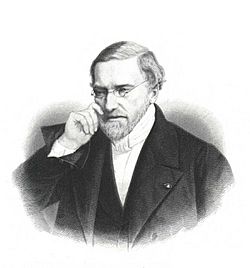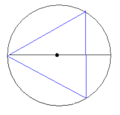Jean-Victor Poncelet facts for kids
Quick facts for kids
Jean-Victor Poncelet
|
|
|---|---|
 |
|
| Born | 1 July 1788 |
| Died | 22 December 1867 (aged 79) |
| Nationality | French |
| Alma mater | École Polytechnique |
| Known for | Traité des propriétés projectives des figures (1822), Introduction à la mécanique industrielle (1829) |
| Scientific career | |
| Fields | Mathematics, engineering |
| Institutions | École d'application de l'artillerie of Metz University of Paris École Polytechnique |
| Academic advisors | Gaspard Monge |
| Signature | |
Jean-Victor Poncelet (born July 1, 1788 – died December 22, 1867) was a French engineer and mathematician. He is known for bringing back the study of projective geometry. His book, Traité des propriétés projectives des figures, is seen as the first important book on this topic since the 1600s.
Poncelet also made big discoveries in math, like how parallel lines can meet at a point at infinity. He also helped develop the idea of complex numbers. As an engineer, he improved the design of turbines and water wheels. He even served as the head of the famous École Polytechnique in Paris. His name is proudly displayed on the Eiffel Tower!
Contents
Jean-Victor Poncelet: A Life of Discovery
Early Life and Education (1788–1814)
Jean-Victor Poncelet was born in Metz, France, on July 1, 1788. His father was a lawyer and landowner. Jean-Victor went to school in Metz at Lycée Fabert.
Later, he attended the École Polytechnique in Paris from 1808 to 1810. This was a very famous school for science and engineering. After graduating, he joined the French Army as a military engineer. He became a lieutenant in the army.
Captured During War
In 1812, Poncelet joined Napoleon's army during the invasion of Russia. He was captured by the Russians and held as a prisoner of war in Saratov until 1814.
During his time as a prisoner, Poncelet wrote his most important math book. It was called Traité des propriétés projectives des figures. This book laid out the basic ideas of projective geometry. He could not publish it until he was released in 1814.
Career and Discoveries (1815–1848)
After his release, Poncelet worked as a military engineer in Metz. In 1822, he finally published his famous book on projective geometry. This book is considered the start of modern projective geometry.
In 1825, Poncelet became a professor of mechanics at the École d'Application in Metz. He taught there for ten years. During this time, he worked on improving the design of turbines and water wheels. He used ideas from old mills in southern France to make his improvements.
In 1837, Poncelet became a professor at the University of Paris. A special teaching position was created just for him!
Leading the École Polytechnique (1848–1867)
In 1848, Poncelet became the Commanding General of the École Polytechnique, the same school he had attended. He led the school until he retired in 1850.
He also wrote another book, Applications d'analyse et de géométrie, which helped explain his earlier work on projective geometry. This book was published in two parts in 1862 and 1864. In 1865, he was made an honorary member of the American Academy of Arts and Sciences.
Poncelet's Important Math Ideas
Poncelet–Steiner Theorem
In 1822, Poncelet discovered an interesting math idea. He found that you can do many geometric constructions using only a straightedge if you are given just one circle and its center point.
A Swiss mathematician named Jakob Steiner later proved this idea in 1833. That is why it is called the Poncelet–Steiner theorem.
Poncelet's Porism
Poncelet's porism is another cool idea in geometry. It says that if you have a polygon (a shape with many sides) that fits inside one conic section (like an ellipse or a circle) and also touches the outside of another conic section, then there are actually endless other polygons that can do the same thing with those two conic sections.
Selected Works by Poncelet
- (1822) Traité des propriétés projectives des figures
- (1826) Cours de mécanique appliqué aux machines
- (1827) Mémoire sur les roues hydrauliques a aubes courbes, mues par-dessous
- (1829) Introduction à la mécanique industrielle
- (1844) Traité de mécanique industrielle physique ou expérimentale (3 volumes)
- (1862/64) Applications d'analyse et de géométrie
- (1874/76) Cours de mécanique appliquée aux machines (2 volumes)
Images for kids
-
The Lycée Fabert in Metz, where Poncelet was a student.
-
Steiner construction of an equilateral triangle.
See also
 In Spanish: Jean-Victor Poncelet para niños
In Spanish: Jean-Victor Poncelet para niños
- Poncelet, a unit of power named after him
- Poncelet Prize, a prize established in 1868 in his honor




